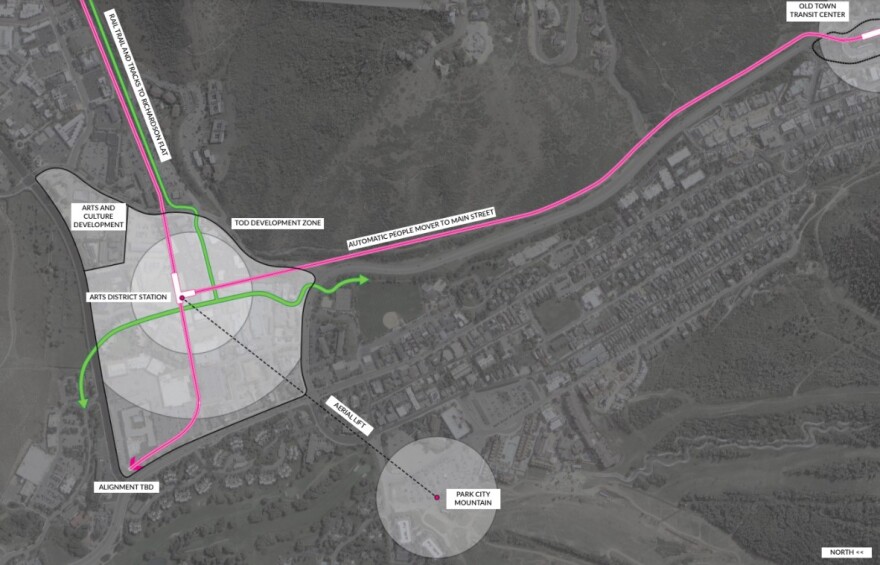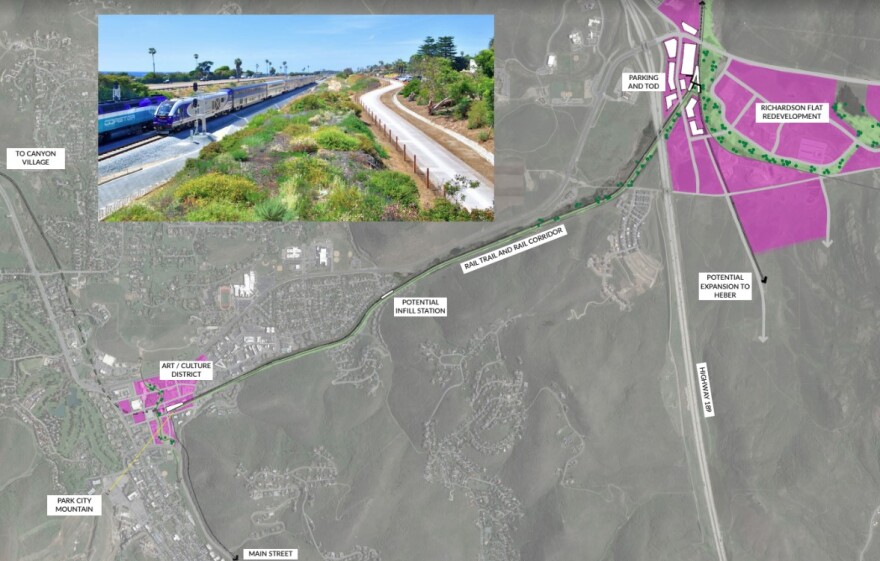Park City resident and public transit advocate Bill Ciraco presented a bold transportation solution for Summit and Wasatch counties to a special meeting of the Park City Rotary Club Tuesday.
Several elected officials, business leaders, and representatives from Park City Mountain and Deer Valley Resort were in attendance.
The idea came to him after he was inspired by a plan to redevelop the old Rio Grande train station in Salt Lake City. He reached out to the landscape architect and transportation engineer who designed the proposal.
They started talking back and forth near the end of 2021, discussing how the plan could extend into the Wasatch Back.
“I think there’s a big need to get people from the Salt Lake City area, whether its workers or tourists who are arriving at the airport, up to Park City without a car,” Ciraco told KPCW after the meeting.
Christian Lenhart, the engineer, said the redeveloped Rio Grande could have room for two new rail lines that could run along I-80, east to Park City and west to Tooele.
That’s where Ciraco took it a step further, working with them on a train route up Parley’s Canyon, turning at Kimball Junction, and working its way into Park City.
“Going up Parley’s will not be easy, but if they could do it 100 years ago, I’m sure with our knowledge and improvements in technology, we could figure out a way to do it,” Ciraco said. “Most likely, it would utilize mostly the median space [on I-80].”
He emphasized at the Rotary meeting that the ideas were conceptual and high-level, or as the architect Cameron Blakely called it — "a pie in the sky.”
“Something like what we’re going to show you happens one step at a time, and you need to start with step one,” Ciraco told the group at the Yarrow.
“And step one is all of you convening here today, to hear these ideas, discuss them, and ask questions.”
Their design makes several predictions about the future of development in the Wasatch Back.
Ciraco said he sees the Harmons project currently in front of the Snyderville Basin Planning Commission as potentially the first step of a major redevelopment of the Outlets mall.
By directing the train through that area, it avoids the I-80/SR-224 interchange. From the Outlets it would head to a transit stop at the proposed Dakota Pacific mixed-use development in Kimball Junction.

“That application is problematic,” he said, calling it a touchy subject.
“But, if we had a big transportation solution that went with that project, maybe it wouldn't be as problematic.”
From Kimball Junction, the train could run down the SR-224 corridor into Park City proper.
Instead of the Old Town Transit Center, they see the main hub in the city as the city-owned land at the intersection of Bonanza Dr. and Kearns Blvd that was previously envisioned as an arts and culture district, as the best spot for a rail station.

“The city is about to hire a vendor and launch a small area plan for that district, and when we considered all the possibilities for Park City, it really became apparent to us, that that part of town really needs to be part of our transit solution,” Ciraco said.
Blakely said from there people could take a gondola to Park City Mountain, or a people mover with a few cars on a single track line up to Old Town.
Ciraco said the people mover wouldn’t require a driver, and could be programmed to suit demand.
From the arts and culture district station, they proposed another train connection running along the Rail Trail through Prospector to Richardson Flat. From there, it could run further into Summit County, servicing Silver Creek Village, Promontory, and eventually Wanship, Hoytsville, and Coalville.

Ciraco said he’s not advocating doing away with the Rail Trail, adding that the plan would involve building a better multi-use trail with a “landscape buffer” to separate the train tracks.
They proposed a central location at Richardson Flat could also allow a rail connection to the Heber Valley.
Ciraco said he’s had brief discussions with representatives of the Larry H. Miller Group, who own a substantial amount of land in Richardson Flat, and Dakota Pacific, as building transit lines there would require their permission. He said he hasn’t spoken to Singerman Real Estate, which owns the Outlets.
“This isn’t about just moving people,” he said. “This is about being serious on our commitment to the environment and climate change. We drive around town, and many of us have signs that say “We Believe Science,” and we believe we need to do something about these issues.
“There’s a tremendous air quality problem in Salt Lake City. I can’t imagine much longer based on the building that’s going to happen around the Jordanelle and around the Snyderville Basin, that in another ten years, we don’t have a massive air quality inversion problem here in the Snyderville Basin and Heber.”
Ciraco said the trains could use hydrogen fuel cell technology, pointing to the Department of Energy-funded industrial hydrogen storage facility being built in Delta, Utah. When completed, it will be the largest of its kind in the world.
Ciraco moved to Park City from New York in 2020, and previously interviewed for the city's planning commission unsuccessfully.
The previous owner of the arts and culture district land proposed a similar idea for rail connections to Kimball Junction and Richardson Flat, as well as a gondola connection to Park City Mountain, more than a decade ago.
Could a future Olympics help?
Ciraco didn’t provide a cost estimate for the rail expansion plan, but said no major project is cheap — pointing to the proposed gondola in Little Cottonwood Canyon that the Utah Department of Transportation (UDOT) has said will cost at least $550 million.
However, he said funding could come with a potential Olympics in Utah in 2030 or 2034.
During a joint meeting of the Park City Council and Summit County Council last year, Salt Lake City-Utah Committee for the Games President and CEO Fraser Bullock said they can help push big ideas forward.
“What is it you want to accomplish over the next 10 or 15 years? We don’t have a checkbook to write checks, but we sure have a lot of momentum and energy and collaboration that we can put together,” Bullock said at the meeting.
“We want to know what your big goals are, what’s your vision?” Utah Olympic Legacy Foundation President and CEO Colin Hilton asked the councils.
“While we can’t maybe solve it financially, boy we have some interesting connections and abilities to be a catalyst for those goals.”
When asked if the UDOT would ever comply with such an unorthodox plan at the Rotary meeting, Lenhart, the engineer, said residents need to voice they don’t want to see more car-centric development. He pointed to a discussion the department had in 2017 about building a double-decker freeway on I-15.
“What’s going to matter most is that we convince our legislators who control the budget for this department, and say ‘this is the kind of things we want our money spent on.’ We don’t want this earmark going to double stacking I-15, or widening things beyond what a reasonable person would say,” Lenhart said.
“There’s been a deficit — cars are not evil, but they’re part of a healthy balanced breakfast, and we’ve been gorging too much on that particular bowl of cereal.”
Ciraco encouraged those passionate about the plan to attend the Park City Council retreat March 2 and 3, where a deep dive on local transportation is scheduled.
The Salt Lake City idea
Blakely and Lenhart see rail service as the future of transit in Utah.
In their spare time outside of their normal day jobs, they designed a proposal to reactivate the historic Rio Grande train station in Salt Lake City.
The Rio Grande no longer serves public transit, as Salt Lake Central Station to the west now serves as the city’s main depot — a change that was made in the years prior to the 2002 Winter Games. The pair said the current transit station isn’t serving its purpose, due to its isolated location and the old Rio Grande depot blocking easy access to downtown.
In a nutshell, their plan would involve consolidating all of the city’s above-ground train tracks into a so-called “train box” underneath 500 West, and would allow rail to run through the Rio Grande again.
Blakely said it takes advantage of Salt Lake’s wide streets, and would allow for the city to grow and develop along with its booming population.
“There’s the opportunity to kind of extend that city grid back into that undeveloped industrial land, resulting in over 40 acres of brand new development opportunity,” Blakely told the Park City Rotary Club.
He pointed to Denver’s recent success revitalizing its Union Station as an example.
Salt Lake City Mayor Mendenhall cited their “Rio Grande Plan” several times during her State of the City address last month. She said the city has applied for federal funding to explore the feasibility of the project.
Utah House Rep. Mike Kohler, who represents parts of Summit and Wasatch counties, previously told KPCW his ultimate goal for transit would be to build off of the Frontrunner in the Wasatch Front, and stretch the trains line up to Park City and Heber.
He said the idea was inspired by his mission trip to Japan, although he doesn’t believe such a project will be done in his lifetime.


